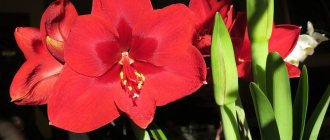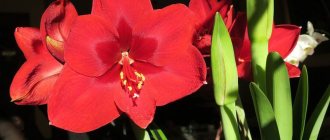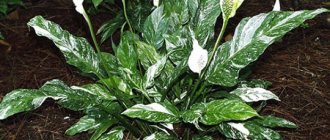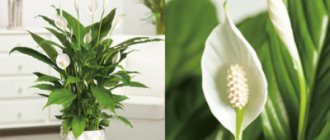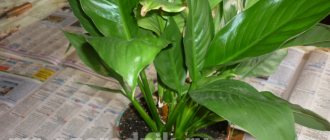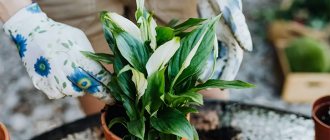Keeping spathiphyllum at home - care features
Caring for a flower at home is not difficult.
First of all, ensure a sufficient level of lighting and temperature in the room. It is important to water and replant the flower on time.
The plant must be placed so that direct sunlight does not fall on it. If you leave it in the shade, the quality of flowering will deteriorate. In summer, flowers are provided with a temperature of 22-24 ℃ above zero. In winter, when spathiphyllum enters a dormant period, it is reduced to +17 ℃.
Note! It is recommended to water the plant at least 3 times a week in summer; once is enough in winter. The humidity in the room should be 40%
At the same time, regularly spray the leaves or wipe them with a damp cloth.
The decorative appearance of the plant largely depends on the quality of the soil. You can make it yourself from leaf soil, peat, sand, humus and charcoal. Spathiphyllum requires sanitary pruning. It is performed after flowering is completed. All dried and withered elements are removed.
Spathiphyllum – photo
As we have already found out, spathiphyllum is not particularly capricious and demanding in everyday life. But they still appreciate it not so much for this as for its stunning beauty. Just look at the photo!
Photo: repairstyling.com
Photo: orchidea-shop.ru
Photo: shop.theplantlounge.com.au
Photo: plodogorod.com Photo: odesign.ru Photo: 7dach.ru
Photo: feeds.feedburner.com Photo: znaysad.ru Photo: sortved.ru
Photo: oir.mobi
Photo: oir.mobi
Photo: flipboard.com
Photo: topfazenda.ru
Photo: cvetkoffandbuketoff.ru Photo: oir.mobi
Photo: oir.mobi Photo: oir.mobi
Photo: pinterest.ru
Photo: ogorod-bez-hlopot.ru Photo: liveinternet.ru
Photo: youla.ru
Photo: cvetyphoto.blogspot.com Photo: botanichka.ru Photo: oir.mobi Photo: oir.mobi
Photo: proroslo.ru
Spathiphyllum: home care, propagation and transplantation
Description and types of spathiphyllum
Like most members of the Aronnikov family, spathiphyllum comes from tropical and subequatorial latitudes. Its natural habitat is the rainforests of Latin America, Indonesia, New Guinea, and the Philippines. There, evergreen thickets predominate in swampy areas, on the banks of rivers and streams.
Spathiphyllum is characterized by rather large lanceolate leaves with raised veins. In the absence of a stem, they grow directly from the soil, sending out many side shoots. Periodically, thin inflorescences-cobs rise from a dark green rosette, covered by one large petal. With its shape, the “blanket” copies the leaves, but differs from them in a more delicate texture and color. The most common shade is white, although as a result of selection or the addition of dyes, bright red, pink, and yellow varieties can appear.
A total of 50 species of plants from the genus Spathiphyllum are classified, which, in turn, are divided into five sections. Popular varieties include spathiphyllum cannofolia, spathiphyllum profusely flowering, Humboldt's spathiphyllum, charming spathiphyllum, spathiphyllum spoon-shaped, and Schlechter's spathiphyllum. Amateur flower growers prefer low indoor varieties.
Spathiphyllum profusely blooming
It compares favorably with its counterparts in its long flowering period and a relatively large number of buds. With proper care, white “flags” will decorate the plant all year round.
Spathiphyllum charming
It boasts large leaves (about 10 cm wide and up to 25 cm long) with a pleasant matte texture. The petal of the peduncle is not snow-white, but greenish, and after the cob withers, even more chloroplasts are synthesized in the 'veil'.
Spathiphyllum Picasso
Valued due to the unusual coloring of the sheets. In one plant they can shimmer in beautiful broad strokes - creamy white, light green, dark green, brown. This variety looks very picturesque in a home greenhouse, even when there are no blooming flowers on it.
Spathiphyllum domino
It also has variegated leaves, but light and dark veins alternate in them more often than in Picasso, and are located more symmetrically. On a two-color background, the white “spread” petals are not as contrasting as on a single-color background, so the fact of flowering has almost no effect on the decorative effect of this species.
Spathiphyllum Sensation
One of the largest indoor varieties, reaching up to 1.5 m in height. Its leaves are dark green, 40 to 80 cm long, and the flowers are large and long-lasting. Such a herbaceous “bush” will help create a tropical atmosphere in the interior; in addition, it perfectly purifies the air, turning carbon dioxide into oxygen.
Botanical description
Spathiphyllum (Women's happiness) is a herbaceous perennial evergreen plant, a representative of the colorful and diverse family of araceae. The name goes back to the Greek language and literally means “spread leaf,” referring to the shape of the flower.
The flower looks like an elongated candle at the end of the peduncle, covered on one side with a semicircular white leaf-spread - as if the candle was being carefully hidden in the wind.
In nature, spathiphyllum grows in two variants: as an epiphyte - settling on the wet and loose bark of tropical trees - and as a chemi-epiphyte, starting development on the forest canopy at the roots and, as it were, climbing up large knotty trunks with aerial roots.
This behavior is somewhat reminiscent of our domestic hops, which are capable of twining and climbing anywhere.
Spathiphyllum leaves are lanceolate, have distinct veins and grow directly from the basal rosette, each leaf has a semicircular groove that encloses the stem and extends to the middle of the leaf.
The spathiphyllum inflorescence grows in the form of a spadix at the end of a long, sometimes longer leaf. It is covered with a blanket, which quickly turns green after flowering. The flowers are bisexual, white or cream.
Main diseases and pests
- Young shoots are affected by spider mites. It is very easy to detect thanks to the web that it produces. Eliminate this nuisance by treating the leaves with soapy water. In cases of severe infestation, insecticides will have to be used.
- Scale insects are one of the very insidious pests that can destroy spathiphyllum. If you find raised spots on the back of the leaf, you should immediately transfer the flower to a quarantine zone located away from other plants. Next, the leaves are rinsed in a soapy solution and treated with tobacco crumbs. Elements affected by the pest are removed. If necessary, chemicals are used.
- In summer, houseplants are attacked by aphids. The destruction of this pest is carried out by repeated treatment of the leaves with special chemicals.
- Mealybugs can also cause plant damage. It hides between the leaves and is easily detected upon careful inspection of the plant. Single pests are removed with an alcohol swab, and large-scale infestations are recommended to be eliminated using special chemicals.
If certain conditions are met and quality care is provided, spathiphyllum Domino will delight you with flowering almost all year round, which will undoubtedly decorate any room.
What to do if it doesn't bloom?
If, with good care, maintaining the temperature and the required humidity, the plant does not bloom, you need to lower the temperature and reduce watering . After a month, return the plant to normal conditions and it will bloom. The main reasons for the lack of flowers are:
- presence of drafts,
- prolonged low temperature, below 18 degrees - move to a room with a higher temperature,
- the place is too dark, as a rule, the variegated spots on the leaves also disappear,
- a large amount of nitrogen fertilizers, forcing the plant to increase green mass.
Spathiphyllum Domino is propagated by seedlings and seeds.
Problems when caring for a plant
Despite the simplicity and unpretentiousness of caring for spathiphyllum, there are often complaints about the lack of flowering, yellowing of leaves and other troubles. Possible problems:
The leaves are turning yellow. This occurs due to lack of moisture. Hard water also leads the plant to a similar state. It is recommended to establish a watering plan and allocate a separate container in which the water will settle. If the color of the leaves has become darker, even brown, then the reason is most likely due to excessive feeding of the plant and an excess of nutrients. The leaves are turning black. This indicates that the plant does not have enough water or, conversely, there is an excess of it. It can also be assumed that there is a lack of nitrogen in the soil. When these points are corrected, the leaves of the plant will gradually renew themselves. The tips of the leaves dry out. This indicates a lack of moisture and excessively dry air. Don't forget that Spathiphyllum Domino is a tropical plant. Constantly spraying the leaves with water will solve this problem. The procedure is alternated with a seven-day shower. Does not bloom in adulthood. The reason may be a lack of water or insufficient feeding of the plant.
In addition, a lack of minerals slows down the development of spathiphyllum, but this problem should be eliminated very carefully. Temperature is also of great importance; it is very difficult to achieve flowering in a cool room. Inflorescences that have already wilted must be removed and the stem cut off at the very roots.
Inflorescences that have already wilted must be removed and the stem cut off at the very roots.
Various difficulties with growing plants can be caused by diseases and pests. To ensure that spathiphyllum Domino (variegated) does not die, you need to constantly monitor the quality of the leaves and soil.
Transfer
Once a plant has been purchased from a flower shop, it should not be left in the same pot. The fact is that store-bought soil does not contain enough nutrients. Therefore, the flower must be placed in another container with previously prepared soil. In addition, a transplant may be necessary in some other cases:
- if the plant has grown, it needs to be propagated;
- signs of any illness appeared.
How to care for spathiphyllum
Location
Spathiphyllums prefer to grow in well-lit places, especially in winter. In summer, you need to avoid direct sunlight on the plants so as not to cause burns to the leaves. You should not move the flower from place to place unnecessarily; spathiphyllum does not like frequent movements.
Temperature
In summer, the most comfortable temperature for the plant will be in the range of 24 - 27°C. In winter, the optimal temperature is 16 - 17°C. At this temperature, the plant begins a period of winter dormancy, it rests and will bloom better in the summer. At temperatures below +15°C, the root ball may freeze and the plant will die. Also avoid sudden changes in temperature and cold drafts in the room where spathiphyllum grows.
Watering
Although spathiphyllum is considered a marsh plant, you should not over-water it; in summer the soil should always be moderately moist, but not flooded with water. Excessive watering can lead to root rot, blackening and death of leaves and flower stalks. In winter, the intensity of watering should be reduced, but the soil in the pot should not be allowed to dry out more than 1 cm in depth.
Air humidity
Spathiphyllum is a plant native to the tropics and therefore loves a humid atmosphere of at least 70%, so it is recommended to regularly spray the leaves with warm soft water from a spray bottle at least once or twice a day, and install a humidifier in the room where spathiphyllum grows. It is also recommended from time to time, but at least once a week, to wipe the leaves of the plant from dust with a damp cloth.
Top dressing
In order to prevent spathiphyllum leaves from becoming covered with yellow spots and losing their gloss, during the active growing season it is necessary to feed the plant with a solution of complex mineral fertilizers at least once every two weeks. During winter dormancy, the plant is fed less frequently, once a month is enough.
Transfer
Young plants are replanted once a year, preferably in early spring, adults - as necessary, as the rhizome fills the volume of the pot, usually after two to three years. The substrate for replanting the plant is prepared from a mixture of turf soil, peat, humus, sand or perlite in a ratio of 2:1:1:1. It has been noticed that spathiphyllums bloom more readily in cramped flowerpots. To avoid possible waterlogging of the soil, take care of good drainage.
Reproduction
The simplest and most popular way to propagate spathiphyllum is to divide the bush in the spring when replanting. The most convenient way is to wash away the rhizome with a stream of running water, carefully separate it and plant it in different pots. For planting, you can use the same substrate or simple peat; on the bottom of the pots you need to lay out a drainage layer of fragments of ceramics or expanded clay.
Pests
Spathiphyllums are usually well resistant to pests and diseases, but with improper care, excessive or insufficient watering, the plant can be affected by spider mites, scale insects or root rot. A sign of plant damage is curling and drying of the leaves, the appearance of brown spots on the glossy surface, and thin whitish cobwebs. To control pests, you need to spray the plant with an insecticide solution according to the instructions for the product. You can use tobacco infusion with soap; to do this, you need to soak a rag in the soap-tobacco infusion and thoroughly wipe the leaves and flower stalks.
If you love the plant and care for it properly, then spathiphyllum will gladly answer you with wonderful flowers and a delicate aroma.
Selection rules
When planting a large spathiphyllum bush or transferring a purchased plant into a new container, pay attention to the choice of pot and soil recommended for indoor culture
Potty
When choosing which pot is needed for spathiphyllum, determine the size of the previous one. The plant is planted in a container that exceeds the former container by 1.5-2 cm in width and height. Flower growers have noticed that spathiphyllum blooms profusely when the roots cover the entire substrate.
Trimming
In a pot that is too spacious, the bush will grow its root system and only then throw out its flower stalks. Containers with holes in the bottom through which excess water flows into the pan after watering are suitable. As with any indoor plant, spathiphyllum requires 1-2 cm of drainage.
Ground
Spathiphyllum develops well in a slightly acidic substrate, pH 5-6.5, loose and light in structure. In such soil mixtures, excess moisture seeps into the pan. The retail chain chooses a universal mixture for aroid or tropical flowering plants, which is mixed with a handful of sand. Many gardeners prepare their own substrate. You can choose the appropriate one, usually the simplest one in execution, from several options:
- 3 parts peat, 2 parts leaf soil, 1 part each humus, sand and bone meal;
- 1 part leaf soil, peat, humus, sand, 2 parts turf soil;
- 1 part of leaf soil and peat, half of turf soil and sand.
Pot
Peat is used as riding peat. Tree bark, coconut fiber, charcoal and brick chips are also added to the substrate for looseness. Additives make up no more than 10% of the total mass. They also put sphagnum moss, which protects the soil mixture from drying out.
When replanting, add fertilizer - 0.5 teaspoon of superphosphate. If the substrate is prepared independently, the soil is spilled with a dark pink hot solution of potassium permanganate.
Fertilizers
For good flowering, spathiphyllum is regularly supported with fertilizing, otherwise a beautiful green bush will grow, but without the original white spathes with flower cobs. Or the flower stalks will be thrown out for a short time and at long intervals
It is especially important to feed the plant in the spring-summer period, when all processes are activated: once every 10-16 days
Priming
In winter, when indoor crops enter a dormant period, fertilize the substrate once every 30 days. Spathiphyllum responds well to organic fertilizers that can be purchased in stores, especially bird droppings. Any universal preparations for flowering indoor plants are also suitable: “Flower”, “Azalea” and others.
If fertilizers are not applied at the end of February or March, the spathiphyllum stops blooming in June, and flower stalks do not form again. At the same time, you should not give too much nitrogen preparations, since the green mass will grow, but not the buds.
Note! Flower growers have noticed that the appearance of brown spots on the leaf blades is evidence of excess nutrients. Housewives often water “female happiness” with chilled liquid after boiling pasta or potatoes, using water from the aquarium
In late autumn and winter, when the intensity of natural light decreases, humic fertilizer “Universal plant balm” is used for spathiphyllum. The drug stimulates culture and helps survive lack of light
Housewives often water “female happiness” with chilled liquid after boiling pasta or potatoes, using water from the aquarium. In late autumn and winter, when the intensity of natural light decreases, humic fertilizer “Universal plant balm” is used for spathiphyllum. The drug stimulates the culture and helps to survive the lack of light.
How to propagate?
Cuttings
It should be carried out in spring or summer. Procedure:
- Cut off the leaf rosette and place in water. You can use raw sand. Wait until roots form.
- If they are already formed, then direct planting into the ground can be carried out.
Dividing the bush
It is better to divide the spathiphyllum bush in the spring. The separated part of the plant should have 3 strong leaf rosettes and part of a healthy rhizome.
Deepen the cuttings to the same depth as in the previous pot. Before dividing, soak the roots with water, wash them and untangle them. Then clean and powder the sections with crushed charcoal.
Seeds
Procedure:
- Plant the planting material in a container with moist soil, which consists of sand and peat. Cover the seedlings with polyethylene.
- Maintain soil moisture by spraying.
- Open the film every day until seedlings form.
- Plant them in separate containers when 2-3 leaves are formed.
Reproduction
Reproduction is usually carried out during transplantation - every spring for the first 5 years, then as needed when the root has grown too much. Spathiphyllum Strauss reproduces by dividing the mother bush :
- Take the flower out of the old pot.
- Carefully separate the lateral shoots along with the roots.
- The separated parts are planted in small containers for rooting.
The new seedling should have 2–3 leaf rosettes.
Long-blooming babies
Compact spathiphyllums grow only 15-40 cm. With high air and soil humidity, these little ones are able to bloom without interruption throughout the year. The most common types you can find are:
The variety "chopin" (sometimes called "chopin") is a derivative of the Wallis species. Spathiphyllum "chopin" has dense, glossy, dark green leaves with lighter depressed veins. Fragrant, with a delicate lily scent, the flower consists of a creamy spadix and a white spathe. In bright light, the back of the bedspread may appear greenish. When the spadix fades, the entire bract becomes green and loses its decorative effect. It is better to remove peduncles with such flowers from the plant in time, cutting them to the level of the leaf petiole, which fits the stems at the bottom. This provokes the formation of new flowers appearing from the axils of other leaves.
Spathiphyllum "domino" belongs to the variegated forms. This means that, due to the special infection of the flower with the variegation virus, it has unevenly colored foliage. Even when there are no flowers on the plant, it looks elegant and exotic: the leaves have many small dots and strokes from dark green to white. Sometimes you come across spathiphyllums with a bluish pattern. The main requirement for caring for such forms is compliance with lighting conditions, because in bright light the leaves lose all their beauty, becoming ordinary green. The height of the “domino” reaches 30 cm.
Spathiphyllum profusely blooming is not named so in vain. Compact bushes (25-35 cm) can be constantly covered with a large number of snow-white flowers. Young foliage usually has a lighter shade, which gives the plant additional charm.
If the room allows, you can choose larger varieties.
Signs and superstitions associated with the plant
There are many signs associated with spathiphyllum. It is believed that when a husband and wife inhale its aroma together, omissions, secrets and suspicions disappear between them. If you place a pot with a plant in the bedroom, this will prevent a man from leaving the family and will return the former passion to the relationship. According to legend, if the shape of a flower becomes round, then the conception of a child is expected soon.
On a note! Spathiphyllum helps single women find love. If you give a flower to an unmarried girl, she will soon meet her future husband.
When two flowers appear on a bush at the same time, it means happiness will come to the family. By purchasing spathiphyllum, you can not only get a bright flowering plant, but also strengthen your relationships with loved ones.
Popular varieties and their photos
To date, botanists know more than 40 varieties of “female happiness.” And only a few of them are used in the field of landscaping and home germination.
Spathiphyllum Wallis
It was named after the discoverer G. Wallis. This species is the most common variety. It is most suitable for growing in apartment conditions, as it is characterized by small dimensions.
The size is 20-35 cm in height. It has a white cob, a narrow oblong veil, which is three times longer than the cob. Spathiphyllum Wallis is unpretentious in care.
profusely blooming
The ancestor of this species is considered to be wild spathiphyllum, which grows in tropical forests, and hybrid descendants are commercially available. It grows up to half a meter in height, that is, medium size.
The leaves are green, oval-shaped, up to 20 cm long. The spathe reaches 12cm, and the peduncle is 25cm. It stands out among others for its abundant year-round flowering.
Charming
This species is much larger than the previous one. The difference lies in the shape and structure of the leaf. The lovely spathiphyllum has an elliptical leaf with visually noticeable veins.
The length of the leaf plate is about 30cm. The stalk connecting the root to the leaf is the same length. In nature, this species can be found in Suriname.
Spoon-shaped
A tall flower, reaching 1 meter in height. The leaf shape is oval, its width is 15 cm. The color of the leaf blade is bright green with a glossy sheen. The petiole grows upward by 50-70cm. Found in tropical forests of Brazil.
Anyone who likes white varieties of spathiphyllum will be interested in reading about such varieties as Alana and Domino, the extraordinary Sweet, the mysterious Chopin, the gentle Sensation, the lovely Cupido, the miniature Strauss and the beautiful Picasso.
Characteristic
This crop is small in size, it is convenient to place it even in a small room and grow it at home. The peduncle is crowned with a cob wrapped in a light sail. After flowering the sail turns green.
The plant is of main interest to gardeners due to its bright and unusual color. The leaf blade has an oval shape, it is variegated, with pronounced veins. There are light spots and stains on a rich green background. It looks so impressive that spathiphyllum attracts attention even when there are no flowers on it.
The Domino species differs from others precisely in the unusualness of its color. It is uneven, since the plant is a carrier of the variegation virus.
For example, the difference between “Domino” and “Gemini” is precisely in the bract: it has an oval shape. The differences between the varieties “Domino” and “Picasso” are that in the second case, variegation is present not only on the leaves, but also on the perianth, which has a pointed tip.
Varieties of spathiphyllum and numerous varieties
There are many different types and varieties of spathiphyllums (according to the latest data, up to 45 species), from the smallest to the giant. They differ in size and color of the spathe and cob. Spathiphyllum hybrids (“Mauna Loa” with leaves often more than 70 cm long) are often found on sale; they are more hardy and bloom all year round.
- Wallis Spathiphyllum (Spathiphyllum wallisii) - the whole plant is 30-40 cm high, with a short rhizome and a rosette of dark green oblong-lanceolate graceful leaves. The cob is white, the spathe is narrow, three times as long as the cob, at first pure white, then turning green. Flowering is abundant and long lasting. The plants are unpretentious and shade-tolerant.
- Spathiphyllum floribundun is a medium-sized plant 50-60 cm tall, oval-lanceolate leaves 15-20 cm long, 9-12 wide. Peduncle up to 25 cm, spathe 10-12. Blooms profusely and for a long time. Flower buds are laid in the axils of healthy leaves, on which the harvest of next year's inflorescences depends.
- Lovely or pleasant spathiphyllum (Spathiphyllum blandum) - larger than the profusely blooming one. A plant with dark green, elongated lanceolate leaves with an extended tip. The petioles are long and strong. The inflorescence is a spadix, surrounded by a greenish-white blanket, which is shaped like a small flag, so the second name of this flower is flagolist. It blooms very profusely (April-June) and has a large number of inflorescences. With good care, flowers appear 2 times a year.
- Spoon-shaped spathiphyllum (Spathiphyllum cochlearispathum) is a large plant, reaching a height of one meter, with oblong-elliptical leaves. Leaves length 30-40 cm, width 15-20. The leaf blade is dark green, glossy, wavy at the edges, supported by a long (50-70 cm), strong petiole. Inflorescence spadix, white. The bedspread is oval, long.
- Spathiphyllum cannifolium is an excellent houseplant with large, bright green, ovate leaves similar to canna leaves. White-green spathe with very fragrant flowers on a yellowish-green spadix
Many varieties can become a worthy decoration for any interior, adding unique sophistication. Some of them reach about one meter in height, sometimes more, and are widely used as solitaire floor compositions and phytodesign of rooms with limited lighting.
How to make a fabulous mini-garden with your own hands and add 100 points to comfort
There is a miniature variety 'Mini', reaching a maximum of 10-12 centimeters in height; 'Chopin' – an elegant variety with round, juicy-bright green leaves, a large snow-white inflorescence cover; 'Sensation', “sensational” - this variety is irresistible - simply a giant, with a large inflorescence, reaching more than one and a half meters in height. The flowering period of some varieties reaches up to six months!
Temperature and humidity
Temperature conditions are very important for the proper development of spathiphyllum “Domino”. Its optimal indicators range from +16 to +23 degrees. Lower temperatures can cause the death of the flower.
Moisturizing the crop is also necessary. It can be carried out using a regular spray bottle. If the room is hot and stuffy, you need to spray the flower 2 times a day: in the morning and evening. In winter, the procedure can be limited to two irrigations per week.
Spathiphyllum Domino. Types of popular house plants
In general, there are approximately forty species of this plant, but much fewer types of spathiphyllum are suitable for home use:
- Wallis. It is an example of plants of its family. Most of the species were bred directly from him. The flower is 45 cm high, and the length of the inflorescences ranges from 4 to 10 cm. Spathiphyllum Wallis is the most unpretentious for home keeping.
- Abundantly flowering. It has a fairly long flowering period, which explains the popularity of the house pet. But the flowers are mostly small - 4–6 cm. The older the plant, the darker the oval leaves become. The stem of the peduncle is approximately 15 cm above the leaf part.
- Domino. A very attractive and memorable plant. The leaves are dark green in color, on which snow-white stripes of an oblong shape are randomly located. The tips of the leaves are pointed.
- Chopin is a small plant, 30–35 cm high. This species has neat elongated leaves with veins. Chopin has a pleasant aroma, which is not typical for artificially bred flowers.
- Cupido. A plant that has become popular due to its abundant flowering, during which 8-10 inflorescences appear. The flowers look gorgeous against the background of green leaves.
- Gemini. The bract is oval-shaped with a sharp end. If you compare Gemini and Domino spathiphyllums, the difference can be seen in the oval-shaped bract. The similarity between varieties is in the spots on the leaves.
- Picasso. It is large in size. The leaves are mesmerizing with their attractive colors; in addition to completely green leaves, there are also completely white leaves. Picasso looks very original and impressive.
- Alana. Has larger sizes. The leaves are bright green, slightly pointed. They are located perpendicularly.
- Mauna Loa. Excellent for home growing. It has a fairly long flowering period, and when cut, the flower will remain fresh for a whole month.
- Sensation. Considered one of the most attractive house plants. If you care for it properly, the flower grows up to 50 cm. The inflorescences also have impressive sizes and a long flowering period.
- Red. This is another spectacular type of plant. According to the classification, it can be defined as anthurium. In some flower shops, sellers water the soil with colored water to create a more refined color of the perianth. It is extremely rare for sale.
Spathiphyllum Domino, which is not particularly difficult to care for at home, is unpretentious to grow, which is especially appreciated by flower growers. Despite the fact that in the wild the flower grows in the tropics, it is not picky about lighting and humidity. The main thing is not to forget to water and replant annually.
Gemini
Spathiphyllum gemini can easily be confused with a domino, but its spots have grayer or ashy shades, and they are located closer to the veins. The flower rosette seems to be compressed into the center, and the leaves themselves are corrugated, wavy, and quite elastic. The photo below shows Spathiphyllum Gemini: Spathiphyllum Gemini
Benefits and harms
In addition to its aesthetic value, one of the positive qualities of spathiphyllum is its ability to purify the air from harmful substances that its leaves absorb.
The answer to the question whether spathiphyllum is harmful to human health can only be positive.
The flower is especially dangerous for people with weak immune systems and children. If you accidentally eat any part of this plant, you may experience burns to your mouth and esophagus, severe cutting pain in the abdomen, and indigestion.
The situation may also be complicated by inflammation of the airways and difficulty breathing. People prone to allergies are at risk of getting skin rashes or other allergic reactions. As a rule, this happens only during flowering; it is the flowers that cause an allergic reaction. At the same time, it manifests itself in the same way in children and adults:
- fear of light;
- sweating;
- convulsions;
- labored breathing;
- weakness;
- skin rashes.
The rest of the time, spathiphyllum, if precautions are taken (limiting access to the flower for animals and children), does not pose any threat, but on the contrary, helps purify the air, remove carbon dioxide from it and saturate it with oxygen
Is spathiphyllum poisonous or not?
What dahlias look like - varieties and types of plants, description
It belongs to the Araceae family, therefore it is considered conditionally poisonous.
Its shoots contain calcium oxalates and oxalic acid, which are dangerous to humans, which, if ingested, irritate the mucous membranes and skin. Eating shoots can be dangerous. Therefore, if you have very young children, you must ensure that they do not accidentally eat the shoots. Accidental use may cause stomach pain and indigestion. In rare cases, an allergic reaction may occur.
Flower care at home
Temperature. Spathiphyllum is a heat-loving and light-loving plant.
The most comfortable temperature for its living indoors is from +18 to +24ºС. Particular attention should be paid to the air temperature in winter. A decrease in the indicator to +10ºС can be detrimental to the plant.
Humidity
A very dry environment can cause leaves to turn yellow. To maintain humidity, frequent spraying with water is necessary; you can install a vessel with water in the room.
Lighting. Place the flower pot in a well-lit place, but without direct sunlight, otherwise the leaf plate may burn. And in a poorly lit place, the leaves will become pale. The most acceptable option is the eastern and western sides.
Watering. Be sure to monitor the moisture content of the soil in the pot. With insufficient watering, the tips and edges of the leaves begin to dry out, and black spots appear. Excessive watering can cause root rot - this is the most common problem with spathiphyllums.
Fertilizer. In the autumn-winter period, it is necessary to fertilize plants with complex fertilizers once every ten days. Before flowering, it is imperative to increase the amount of potassium and phosphorus and fertilize with phosphorus-potassium fertilizers. When the flowers appear, stop feeding, leaving only abundant watering. Brown spots often appear on the leaves due to a lack of nitrogen.
History of appearance
The flower was first noticed by the German botanist Gustav Wallis in Colombia in the 19th century. In the mid-twentieth century, this plant was brought to Europe and has since been grown as an indoor plant.
Spathiphyllum in the interior
Spathiphyllum is the plant's homeland - South America, East Asia, Polynesia.
Spathiphyllum Domino: home care
Spathiphyllum "Domino" leaves have an original pattern of white specks or spots on a green background.
This variety was bred from Spathiphyllum Wallis and is therefore similar in size and type of flower care.
Next, we will show a few photographs and talk about caring for spathiphyllum “Domino” at home.
Spathiphyllum "Domino" is considered a rather unpretentious plant in terms of care and responds responsively to the care of the grower.
The “Domino” variety is great for beginners or slightly “forgetful” people, but at the same time, with proper and regular care, spathiphyllum reveals itself in all its beauty.
So it is much better to follow a few simple rules for caring for spathiphyllum “Domino” and enjoy the splendor of the flower and benefit for yourself.
LIGHTING. The Domino variety prefers a large amount of diffused light with minimal direct sunlight. The flower can grow in partial shade, but the quality of flowering deteriorates and the decorativeness of the leaves decreases.
We talked about the optimal cardinal directions for flower placement in the main article on caring for spathiphyllum.
TEMPERATURE. Spathiphyllum "Domino" must be provided with a certain temperature regime: 18-24 degrees throughout the year. Protect the plant from sudden temperature changes and drafts.
HUMIDITY. Spathiphyllum "Domino" needs fairly high air humidity - at least 40%. In summer, spray spathiphyllum every day, at least every two days.
THE SOIL. Spathiphyllum "Domino" loves a light, loose and nutritious soil mixture. Use a universal substrate with a peat content of at least 25% or prepare it yourself (the substrate recipe is described in the main article).
WATERING. During active growth and development (spring-summer) of the spathiphyllum “Domino”, the soil mixture should be kept moist at all times. In the autumn-winter period, water the flower after the top layer of soil has dried 1-2 cm.
The watering schedule is approximately this: in the summer every 2-3 days, and in the winter every 7-8 days. Water the plant only with soft water at room temperature.
What to do if you are going on vacation or a business trip, see the special article: “HOW TO WATER FLOWERS DURING A LONG ABSENCE.”
Spathiphyllum Domino: feeding, propagation, replanting, pests
We continue the story about caring for spathiphyllum “Domino” at home and then there are no less important and useful tips.
FEEDING. In spring and summer, feed Domino once every two weeks. As a top dressing, use half the dose of liquid complex fertilizer.
REPRODUCTION. Spathiphyllum is most convenient and easiest to propagate by dividing the rhizomes during the next plant transplant in the spring.
Read more about this and other methods of reproduction in the main article, so as not to repeat it for those who have already read.
TRANSFER. Replant young spathiphyllum "Domino" every year (preferably together with a clod of soil), and after 4 years you can replant the flower every 2-3 years. The plant has rather fragile rhizomes, so carefully remove the flower from the pot.
PESTS and DISEASES. To prevent the occurrence of diseases and pests, proper care of spathiphyllum “Domino” plays a key role.
Inspect the plant regularly, especially the undersides of the leaves, using a magnifying glass.
BLOOM. Spathiphyllum usually blooms for 6-8 weeks from March to September. A plant may not flower for various reasons.
WHY DOES SPATHIPHYLLUM "DOMINO" NOT BLOW?
Spathiphyllum "Domino" does not bloom, as a rule, due to: too much or too little light, nutrients, drafts or root rotting.
Changing the location of the flower, trimming old leaves, changing the frequency and abundance of watering in one direction or another can help you.
With proper care, according to experienced gardeners, sometimes the shock method helps: reduce watering for 3 weeks, then do not water it at all for 8-10 days, and after that the plant is fed and watered as before. However, be careful not to overdo it.
We discussed possible problems with spathiphyllum in detail in the main article.
We recommend you take a look – there are a lot of useful points there!
Here is a spathiphyllum Domino and care at home, which we hope did not seem difficult for you.
In practice, you will see for yourself that the spathiphyllum “Domino” variety does not require so much effort and attention, but in return it cleans our home and brings beauty to it!
We wish you a luxurious spathiphyllum and many positive impressions!
Domino
Spathiphyllum domino also has light areas, but they are tiny, thread-like, located on the leaf plate in the form of small veins or intermittent stripes. The leaves of this variety are compact, bushy, growing upward rather than bushing to the sides. In the photo below is the variety Spathiphyllum Domino: Spathiphyllum Domino
Spathiphyllum Domino: home care
This flower is quite unpretentious in maintenance; even a novice gardener can handle it. It is also suitable for absent-minded people who may sometimes forget about watering. But, of course, if you care for it correctly, the flower will look much more beautiful.
- Temperature. The spathiphyllum should be provided with a stable temperature from 18 °C to 24 °C. He doesn't like drafts and sudden changes in temperature.
- Lighting. The best option is a lot of diffused light, but without direct sunlight. Partial shade is also acceptable for Domino, but it makes its leaves less bright and negatively affects flowering.
- Watering. In spring and summer, the plant should be watered once every 2-3 days so that the soil is constantly moist, because active growth and development occur during this period. In autumn, the soil should dry out 1-2 cm deep, so the frequency of watering is reduced to once a week.
- Humidity. An air humidity of 40% is suitable for spathiphyllum. To maintain it at this level, in the summer you will have to spray the flower every day.
- Soil and fertilizing. Domino needs light, loose soil rich in nutrients. At least a quarter of its composition should be peat. Fertilizing is best done in spring and summer, approximately once every two weeks. 1/2 dose of liquid complex fertilizer is suitable.
- The only difference between summer and winter care is watering. In winter, you should not water the plant abundantly, so as not to freeze its roots. It’s also not worth fertilizing, because at this time it is in a dormant period.
Bloom
Spathiphyllum is a perennial plant. With proper care it can bloom almost all year round. On average, flowering takes place in the spring-autumn period, when indoor light sufficiently nourishes the leaves.
When and how?
Spathiphyllum Domino begins to bloom in early spring after full development. In a young plant, the first flowering begins after two years. An inflorescence of a yellowish or white hue is formed on a long stalk, which is covered with a snow-white flower.
Care before and after flowering - features
- Before the flowers appear, you need to fertilize with potassium and phosphorus once every three weeks.
- The plant loves moisture, so it needs to be watered and sprayed regularly.
- Dead inflorescences must be removed in time. This will allow Spathiphyllum to produce new buds.
Important! At the end of flowering, you should stop frequent watering and fertilizing.
What to do if there are no buds?
The absence of flowering is an important signal about the condition of the plant. This happens in case of improper transplantation, insufficient lighting, during root rotting or lack of nutrients in the soil. You need to take care of proper care.
When the plant receives enough moisture and nutrients, but flowering is not observed, you need to try the shock therapy method:
- Over the course of 3 weeks, gradually reduce the amount of watering.
- Do not water the plant at all for eight days.
- Next, you should immediately begin standard fertilizing and watering. This should awaken Spathiphyllum.
Step-by-step instructions for care at home
Selecting a location
Spathiphyllum Domino is planted in bright places, on window sills without direct sunlight. Dry air and drafts should be avoided. It is forbidden to keep the plant under direct air conditioning.
What should the soil be like?
The best soil for growing plants is a special mixture. Sold in a flower shop. You can make the mixture yourself, for this you will need to combine in equal parts:
- sand;
- peat;
- humus;
- leaf soil;
- charcoal;
- fine tree bark.
Landing
- When planting a plant, the bottom of the pot is filled with expanded clay.
- Soil is poured out to half the container.
- Having distributed the roots, the plant is installed and covered with the remaining mixture.
- The soil is lightly compacted for stability and watered.
Temperature
The most optimal temperature for keeping Spathiphyllum Domino is from 18 to 24 degrees.
In winter, avoid temperatures below 15 degrees and reduce watering, and in summer, avoid direct sunlight, which burns the leaves, and water more often. Temperatures above 28-30 degrees are dangerous for both the plant and the soil.
Watering
Watering is carried out with room water. In the hot season, one watering and spraying every three days is enough. Depending on the climate, increase the amount of watering, but not water, so as not to contribute to rotting of the roots. In winter, the plant only needs 1 watering per week.
Top dressing
Fertilizing is only needed during flowering. Use calcium and phosphorus or complex fertilizer. When choosing mineral fertilizers, you should avoid nitrogen in the composition - because of it, the plant stops blooming.
Important! Fertilizer is applied at a concentration of one and a half grams per liter of water.
Trimming
Spathiphyllum Domino does not require mandatory pruning. Only dead leaves and flowers are removed. If there are too many leaves for the size of the pot, it is better to replant the plant.
Transfer
The plant is replanted at the end of winter, when the nutritional system has not yet awakened. The pot should be 4-5 centimeters larger than the root of the plant. Due to the thickness of the root part, the flower is replanted with soil. Drainage is placed at the bottom of the pot, the plant is installed and covered with earth, compacted. After transplantation, it requires abundant watering.
What depends on the type?
When growing spathiphyllum, you need to know what species it belongs to . After all, the conditions of detention depend on this. Spathiphyllums are unpretentious, but some species are quite capricious. For example, when the earthen clod dries out, spathiphyllum cannofolia will simply shed all its leaf mass. But mini spathiphyllum will respond to waterlogging of the soil by rotting its roots.
All spathiphyllums do not tolerate direct sunlight, drafts, and do not like large temperature changes - which is why they are not transferred to balconies in the summer. Most spathiphyllums require high air humidity and regular spraying. You also need to take into account the size of the species.
Giant spathiphyllums will be more appropriate in a spacious room ; dwarf species will fit perfectly on an indoor window sill.
Possible difficulties during cultivation
Spathiphyllum Wallis is quite resistant to various infections and fungi, as well as attacks from harmful insects. However, there is a possibility that the plant can be damaged by spider mites, which can cause the foliage to become covered with rusty spots. To get rid of these parasites in the room where the plant is kept, it is necessary to restore the optimal humidity regime. You can also spray with insecticides such as “Aktara” or “Aktellik”. Mealybug attacks, which can gradually destroy the flower, are also common. To eliminate the insect, use special preparations - “Calypso”, “Fitoverm”, “Biotlin”, “Confidor”. An effective folk remedy is alcohol: soak a cotton swab in it, then wipe the affected areas of the plant. Treatment is carried out until the parasites are completely eliminated. If the leaves curl into a tube, check to see if aphids have settled on the foliage. If a parasite is detected, treatment with appropriate drugs is required - “Iskra”, “Tanrek”. If the tips of the leaves turn black, reduce soil moisture to a minimum until the spathiphyllum is completely restored. All blackened foliage should be removed.
We recommend that you find out why spathiphyllum leaves turn yellow.
There can be more than one reason for yellowing foliage - either low air humidity or nutrient deficiency. In the latter case, you cannot do without transferring it to a new pot with fertile soil. There may be a need to increase watering for a short period and also check for harmful insects. You can carry out preventive treatment with light anticoccidal agents. We hope that caring for indoor spathiphyllum Wallis will not be difficult for you. In return for your care, the flower will give you all its beauty and beneficial properties.
Diseases of the flower female happiness (spathiphyllum)
Most often, 2 diseases occur in spathiphyllum.
Root rot. The disease can be determined by the condition of the leaves - at first they turn pale, then begin to turn yellow and wither. The cause of the disease is most often excessive soil moisture.
At the first signs of root rot, the plants should be transplanted into a new pot and fresh soil as quickly as possible, cutting out the damaged areas and disinfecting the pot.
Late blight. The first signs of the disease are rot, which appears at the base of the shoots. Then the fungus rises up the leaves, affecting the plant more and more. Diseases are provoked by too frequent and abundant watering and low air temperatures.
To treat late blight, the drugs Consento, Revus, and Ordan are used. (3)


